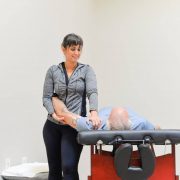Persistent Shoulder Pain could mean Misdiagnosis
Persistent Shoulder Pain could mean Misdiagnosis
We’ve been hearing a lot of complaints lately about shoulder pain. Your shoulder joint is one of the most complex and mobile joints in your body. It’s made up and supported by an intricate structure of bones, tendons, ligaments, muscles and connective tissue. They all work in unison to keep it functional.
You’ve got the head of your shoulder joint (looks like a round ball) inserting into a socket within your shoulder blade (your “wing”). This makes up your shoulder joint and is supported by a joint capsule, ligaments, and your rotator cuff muscles.
Surrounding and supporting your shoulder blade and shoulder joint is your cervical and thoracic spine. (neck and upper back). This has both large and small muscles helping to support your ability to push, pull, reach, and raise your arms overhead.
Intertwined within all of that is a delicate web of nerves and blood vessels… No wonder shoulder pain can be a challenge to treat – never mind diagnose.
If you see your doctor about shoulder pain, they will typically want to take a closer look via X-rays and/or MRI’s. X-rays will show you all the bony parts of your joint – to see if anything is broken and check for arthritis. MRI’s will see if anything is torn or worn away, such as rotator cuff or labral tears.
Relying on imaging to diagnose your shoulder pain can be tough. Or any joint pain for that matter. It’s entirely possible to have arthritis, a torn rotator cuff, or torn labrum – and still have a perfectly functioning shoulder. The problem is we only get things looked at when we are in pain. So, there is no way to know for sure if you’ve had these “abnormalities” already, and if they are the true reason for your shoulder pain.
For example, it’s estimated that between 20-50% of people over aged 50 have “asymptomatic rotator tears”. Meaning – they walk around with a torn rotator cuff and have zero pain in their shoulder. Just because an X-ray or MRI says so – doesn’t mean it is so. And it’s a big reason why so many folks suffer unnecessarily with persistent shoulder pain.
If I meet someone with shoulder pain that hasn’t gone away – the first thing I question is whether or not we have the correct diagnosis. With shoulders, misdiagnosis is all too common given the complex nature of the joint and surrounding structures.
Here are some clues to help you figure out if your persistent shoulder pain has been misdiagnosed:
Where is your pain?
When pain is coming from the shoulder, the pain will typically be felt directly in three places. In front of your shoulder, on top of your shoulder, or in a more involved shoulder problem (like a rotator cuff injury) down the side of your upper arm. But it will never go below your elbow. If the pain goes past your elbow and into your forearm or hand – radiates above your shoulder into your neck (the upper trap area) – or deep inside your shoulder blade or middle back – odds are pretty good you’re dealing with a neck problem – and not just a shoulder problem.
If you don’t address your neck, your shoulder pain will continue to persist. I can’t tell you how many people I’ve seen get unnecessary rotator cuff surgery because of this misdiagnosis.
Have you lost mobility in your shoulder?
Lack of mobility is a common symptom associated with a rotator cuff injury or the dreaded “frozen shoulder.” These are, indeed, shoulder problems. So if your pain is persisting, you probably have the correct diagnosis, just the wrong treatment approach.
However, one overlooked area when it comes to shoulder stiffness is your middle back (thoracic spine). If your thoracic spine has mobility restrictions – or even weakness that leads to stiffness (our joints stiffen up to compensate for weakness/instability) – it will impact your shoulder joint. Stiffness in your thoracic spine can inhibit your shoulder mobility. Over time, this lack of mobility will irritate structures within your shoulder joint, causing pain.
If you’ve got persistent shoulder pain and feel like you’ve tried everything, get your middle back checked out. This could be your misdiagnosis.
Do your symptoms involve numbness, tingling or burning?
These are signs of nerve compression or irritation. If that’s happening – it’s likely coming from your neck or upper portion of your middle back (cervicothoracic junction). It could be due to a bulging disc or a restricted/faulty movement pattern that is irritating nerve roots (or discs) in your spine. An isolated shoulder problem typically does not involve nerve root compression or irritation. Sometimes certain trigger points in your rotator cuff muscles can refer pain. But this usually feels quite different from what I’m referring to.
Do you consistently feel pain, numbness, tingling or burning in your shoulder blade, middle back, or down your arm? Especially if it seems to move around during the day? Then it’s likely not a shoulder problem. In the medical world we call this presentation “cervical radiculopathy”. If you continue to experience persistent shoulder pain and you’ve got any of the symptoms I just mentioned, this is probably your misdiagnosis.
Confused? I don’t blame you.
The moral of this story is that if you’ve got persistent shoulder pain and given treatment your best shot, then you’ve likely been misdiagnosed. Shoulder pain loves to disguise itself as a spine problem (neck and/or middle back) even when you don’t feel pain in your spine.
Whatever you do, don’t resort to any surgery or major procedures until you’ve thoroughly explored these areas with a mechanical pain expert who knows where to look.
If you are local to Portsmouth, NH…
Consider reaching out to one of my specialists by requesting a free discovery visit HERE. They will ask you all about what’s been going on – and see if we would be the best fit to help you.
Dr. Carrie Jose, Physical Therapist and Pilates expert, owns CJ Physical Therapy & Pilates in Portsmouth and writes for Seacoast Media Group. To get in touch, email her at [email protected].












